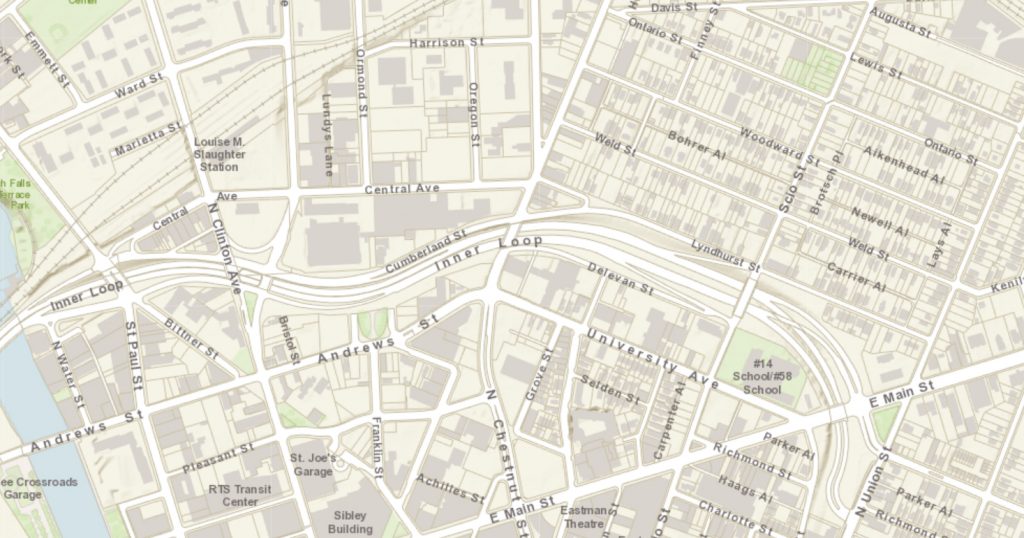
Public Meetings for Inner Loop North Project
- June 22, 2021
- 2:10 pm
- June 22, 2021
- 2:10 pm
Your input is needed!
The City of Rochester is hosting public meetings to gather YOUR feedback on the infill of the north section of the Inner Loop (visit the City’s project website here). If done sensitively, this project has the potential to transform and repair neighborhoods that were devastated by Urban Renewal and construction of the Inner Loop.
Public meetings will take place:
Wednesday, 6/23 – 3-6PM @ YMCA Center for Equity (53 Lewis St.)
Friday, 6/25 – Virtual session, 12-1:30 PM
Tuesday, 6/29
-
- 9-10:45 AM @ Genesee Brewhouse (25 Cataract St.)
- 3-6 PM @ RIT Center for Urban Entrepreneurship (40 Franklin St.)
Visit the Inner Loop North website for more information about the project and public meetings.
Along with residents on both sides of the Inner Loop and our friends at Hinge Neighbors, we are advocating for a neighborhood-driven and community-centered design that will physically reconnect these two neighborhoods and help foster equity and investment.


As you can see when comparing a current map with the historic maps that pre-date the Inner Loop, this section of the city once had a typical urban street grid, with short blocks, human-scaled buildings, and pedestrian friendly streetscapes. This is in stark contrast to the sunken highway of the Inner Loop, which creates a vast chasm between downtown and what was once known as the 4th, 7th, and 16th Wards (today the 16th Ward is generally referred to as the South Marketview Heights Neighborhood). Entire blocks of homes were removed in the 16th Ward to make room for the Inner Loop. A little farther west (just north of the Cumberland St, post office), the 7th Ward neighborhood was completely demolished, displacing an entire neighborhood. Significantly, the 7th Ward was one of only two neighborhoods (the other was the Third Ward, today more commonly known as Corn Hill) where African Americans were allowed to live. Racist real estate, zoning, planning, and banking practices enforced racial segregation.


Besides the Inner Loop “moat,” the large scale demolition of historic buildings, and the displacement of hundreds of families, Urban Renewal also removed parks and public spaces like Franklin Square (what remains is now known as Schiller Park) and Anderson Park; truncated and cut off small neighborhood streets like Gibbs and major thoroughfares such as University Ave.; and left landmark community buildings like the Cumberland St. Post Office isolated and difficult to access for pedestrians and motorists alike.
The filling in of the Inner Loop North presents us with a once-in-a-lifetime opportunity to correct and repair some of the damage to the social, cultural, economic, and built fabric of our city. It provides an opportunity to reconnect downtown to its residential neighbors to the north; to reconnect other severed neighborhoodss; and to re-build an urban street grid. Most importantly, it provides an opportunity for us to repair some of the harm done to the residents of these neighborhoods and for Rochester to become a nationwide model for equitable highway removal and infill.
However, in order for the Inner Loop North project to accomplish these goals, the project design must serve the needs of the neighborhood residents who stand to benefit. Some of the design elements for which we are advocating:
- Recreate the urban street grid. Maintaining the footprint of the highway and simply bringing the Inner Loop to grade is not sufficient. In order to reconnect neighborhoods, the street grid that the Inner Loop destroyed must be restored.
- Create a more pedestrian friendly environment. This can be accomplished through properly scaled streets that are no more than two lanes wide.
- Infill development that meets the needs and desires of residents. Residents on the north side of the Inner Loop have made it clear that they wish to see small-scale residential development that can foster home ownership. Think townhouses and freestanding single family homes as opposed to block-long four story apartment buildings. Creating opportunities for small, locally owned businesses to establish themselves, serve residents, and foster an economically vibrant neighborhood is also important.
- Inclusive design that encourages movement between different neighborhoods on either side of the Loop and that provides amenities for the full range of city residents.
SHARE





1 thought on “Public Meetings for Inner Loop North Project”
One of the treasures of Rochester is it’s Public Market. Used and useful for all. A meeting place with a purpose. It’s just north of the dreaded inner loop. Please include ideas of improved access to the Market in the renovation/restoration plans for the hated loop.
Comments are closed.